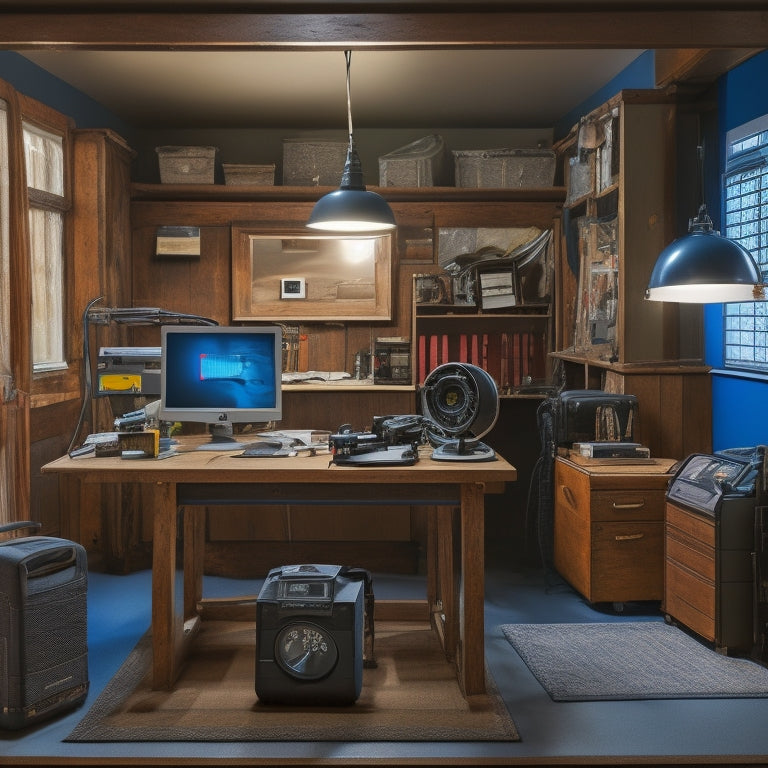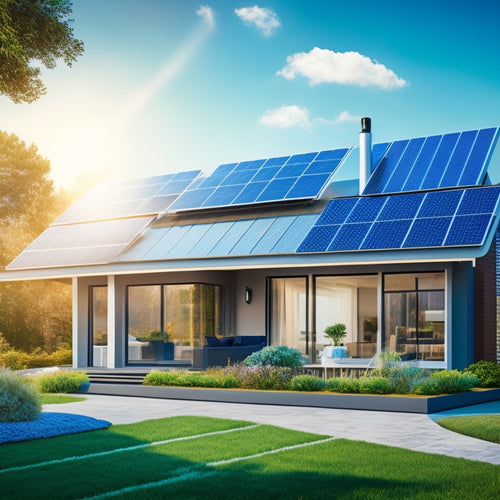
Essential Home Energy Audit Tools: DIY Guide
Share
You're about to set out on an important expedition to convert your home into an energy-efficient haven, and it all starts with the right tools and a DIY attitude. To get started, you'll need to understand your energy usage by analyzing utility bills, identifying consumption patterns, and calculating energy usage in kilowatt-hours. Next, compile a home energy audit checklist, focusing on outdoor inspection points, indoor appliances, and safety hazards. Essential DIY audit tools include flashlights, tape measures, and thermal imaging cameras, which help detect energy leaks and identify gaps in insulation. As you explore further, you'll uncover more opportunities to optimize your home's energy efficiency and reduce your carbon footprint.
Key Takeaways
- Utilize essential DIY audit tools like flashlights, tape measures, ladders, energy audit apps, and thermometers to ensure a comprehensive energy audit.
- Thermal imaging cameras help detect energy leaks, identify gaps in insulation, and visualize home energy efficiency for prioritized repairs and upgrades.
- Blower doors, smoke pencils, and infrared scanners aid in detecting air leaks, which can significantly reduce energy loss and enhance comfort when addressed.
- Monitoring energy generation and analyzing solar panel efficiency optimize performance, identify improvement areas, and ensure proper installation and maintenance.
- Energy efficiency rating systems like Energy Star and HERS Index provide standardized comparisons with similar homes, helping identify areas for energy efficiency improvements.
Understanding Your Energy Usage
Since you're considering a DIY home energy audit, it's important to start by understanding your energy usage. This involves analyzing your energy consumption habits, which can reveal areas of inefficiency in your home.
Begin by examining your utility bills from the past year to identify patterns and trends. Review your energy usage during different seasons to see how it fluctuates. Calculate your energy consumption in kilowatt-hours (kWh) and compare it to the national average. This will give you a baseline for your energy usage.
It's also essential to conduct monthly checks on electrical connections to guarantee peak performance of your energy systems and prevent corrosion. Additionally, regular cleaning of key components, such as air filters and radiators, assures safety and reduces energy consumption.
Next, break down your energy consumption by fuel type, such as electricity, gas, or oil. This detailed analysis will help you pinpoint areas where you can make adjustments to reduce your energy consumption and save money.
Home Energy Audit Checklist
You'll need to examine your home's exterior and interior to identify areas of energy inefficiency, so start by compiling a checklist of outdoor inspection points, such as inspecting windows, doors, and roofing for air leaks and damage.
Regular inspection of solar panels, like those used in EV charging stations, is also essential for ideal performance and can be a great way to reduce energy losses.
You'll also want to track your energy usage patterns to understand when and where energy is being wasted, including monitoring your utility bills and identifying areas of high energy consumption.
Additionally, be sure to include a safety concerns checklist to identify potential hazards, such as faulty wiring or expired smoke detector batteries.
Outdoor Inspection Points
As you begin the outdoor inspection, take a close look at the exterior walls, paying attention to any gaps or cracks in the foundation, walls, and windows.
During your roof inspection, check for damaged, missing, or loose shingles, and inspect flashing around chimneys, vents, and skylights.
Consider the importance of roof preparation for energy system installation, guaranteeing structural integrity and adhering to Gross Vehicle Weight Rating (GVWR).
Assess the landscaping impact on your home's energy efficiency, considering factors like tree shade and wind direction.
Inspect exterior insulation, confirming it's properly installed and not damaged.
Perform a ventilation assessment, checking for proper airflow and functionality of outdoor appliances.
Check window seals for gaps and cracks, and inspect drainage systems to verify they're functioning correctly.
Don't forget to evaluate weather stripping around doors, patio efficiency, and sun exposure, which can greatly impact your home's energy consumption.
Energy Usage Patterns
Frequently, homeowners overlook the significance of their daily habits and how they impact their energy consumption. As you conduct your home energy audit, it's crucial to examine your energy usage patterns.
Identify peak usage times and analyze your energy habits to understand consumption trends. Observe behavioral patterns, such as leaving lights on or running appliances during off-peak hours, and note usage fluctuations between weekdays and weekends.
Assess the efficiency of your appliances and how they contribute to your overall energy consumption. Additionally, consider the lifestyle impact of seasonal variations, like increased heating or cooling demands during winter or summer.
Many homeowners can reduce their carbon footprint by adopting sustainable practices, such as renewable energy sources and optimizing their energy usage during off-peak hours.
Safety Concerns Checklist
Safety concerns are a vital component of your home energy audit, and identifying potential hazards is fundamental to guaranteeing a safe and efficient living space.
As you conduct your DIY audit, pay attention to potential fire hazards, such as frayed cords, overloaded outlets, and malfunctioning appliances. Confirm that your home's electrical safety is up to par by checking for outdated or recalled electrical components.
Also, inspect your home's ventilation systems to prevent carbon monoxide buildup. Take note of any musty odors, water damage, or signs of pest infestation, which can indicate hidden safety risks.
Additionally, just like how range anxiety limits electric vehicle adoption, it's essential to address safety concerns that can hinder a safe and healthy living environment.
Essential DIY Audit Tools
Your DIY home energy audit toolkit should include a few essential tools to help you identify areas of energy inefficiency.
You'll need a flashlight to inspect dark areas like crawlspaces and attics. A tape measure will come in handy for measuring insulation gaps and window sizes.
Don't forget a ladder to access hard-to-reach areas. Energy audit apps like Home Energy Audit or Energy Auditor can guide you through the process and provide useful perspectives.
For insulation testing, use a thermometer to check for temperature differences between insulated and non-insulated areas. Additionally, a blower door test kit can help you detect air leaks.
With these tools, you'll be well-equipped to identify energy-wasting areas in your home.
Thermal Imaging Camera Uses
You'll find thermal imaging cameras to be incredibly useful for detecting energy leaks fast, as they can quickly identify areas of heat loss or gain.
By using a thermal imaging camera, you can inspect walls and ceilings to pinpoint exactly where energy is escaping.
Analyzing temperature patterns with a thermal imaging camera will give you a clear visual representation of your home's energy efficiency.
Detect Energy Leaks Fast
Thermal imaging cameras are the homeowner's most reliable ally in detecting energy leaks fast, as they can visually depict temperature variations that indicate heat loss or gain.
You'll identify areas where heat is escaping or entering your home, pinpointing energy leak detection. This allows you to target insulation evaluation and upgrade efforts.
Using a thermal imaging camera, you'll quickly spot gaps in insulation, ductwork, and windows. You'll also detect hidden issues like moisture intrusion or electrical hotspots.
With this data, you can prioritize repairs and upgrades to optimize your home's energy efficiency, saving you money and reducing your environmental footprint.
Inspect Walls and Ceilings
Inspecting walls and ceilings with a thermal imaging camera helps identify temperature anomalies that signify heat loss or gain.
You'll be able to pinpoint areas where wall insulation may be lacking or compromised, allowing heat to escape.
Check for ceiling leaks, which can also contribute to energy loss.
Use the thermal camera to scan walls and ceilings in various areas of your home, including exterior walls, interior walls, and ceilings above living spaces and crawlspaces.
Take note of any temperature variations, as these can indicate gaps or weaknesses in the insulation.
Analyze Temperature Patterns
Your thermal imaging camera captures a wealth of data, but it's up to you to decipher the temperature patterns that will lead to meaningful energy-saving improvements.
To do this, you'll need to analyze the images and identify areas of temperature fluctuations. Look for hotspots around doors, windows, and electrical outlets, as well as cold spots near insulation gaps or poor air sealing.
Consider seasonal variations in your analysis, as temperature patterns may change depending on the time of year. For example, you may notice more heat loss in winter or heat gain in summer.
Air Leak Detection Methods
Air leaks can be a significant contributor to energy loss in your home, and detecting them is essential to identifying areas for improvement.
You'll need the right tools to detect air leaks. A blower door is a powerful tool that helps you identify leaks by depressurizing your home. A smoke pencil can be used to visualize air leaks, making it easier to pinpoint their location. An infrared scanner can also be used to detect temperature differences that may indicate air leaks.
Once you've identified leaks, it's time to seal them. Use weather stripping, acoustic leak sealants, draft stoppers, thermal curtains, and a caulking gun to seal gaps and cracks.
Home Energy Generation Monitoring
You'll want to monitor your home's energy generation to optimize its performance and identify areas for improvement.
For solar panel systems, this means tracking the panel's performance and energy output to guarantee it's meeting its expected capacity.
Solar Panel Performance
The rooftop photovoltaic array, silently capturing sunlight, is an important component of your home's energy generation system.
As a homeowner, you've invested in a solar panel installation to utilize renewable energy and reduce your reliance on the grid. To guarantee peak performance, regular solar panel maintenance is vital.
You'll need to inspect the panels for debris, dirt, or physical damage, which can hinder energy production. Check the connections and wiring for signs of wear or corrosion.
Additionally, monitor the panel's temperature, as excessive heat can reduce efficiency. By performing routine checks, you'll be able to identify potential issues early on and maintain the health of your solar panel system.
Energy Output Tracking
Monitoring your solar panel system's energy output is essential to ensuring ideal performance and identifying potential issues.
You'll want to track energy production in real-time to optimize your system's efficiency. This involves monitoring energy consumption trends to pinpoint areas of improvement. By doing so, you can maximize the renewable energy benefits of your solar panel system.
Invest in a monitoring system that provides detailed data on energy output, voltage, and temperature. This data will help you identify potential issues, such as shading or panel degradation, allowing you to take corrective action.
With accurate tracking, you'll be able to optimize your energy output, reduce your reliance on the grid, and enjoy the full benefits of renewable energy.
Solar Panel Efficiency Analysis
Within your DIY home energy audit, evaluating solar panel efficiency is vital to understanding their impact on your energy consumption.
You'll want to assess the type of solar panels installed, as different types have varying efficiency rates. Proper solar panel maintenance, such as cleaning, is essential to optimize energy production.
You'll also want to take into account the solar power benefits, including reduced energy bills and environmental advantages. Confirm your solar installation is done correctly, considering solar array orientation and local building codes.
Research solar energy incentives, such as tax credits, and factor in the solar panel lifespan, typically 25-30 years.
Stay up-to-date on solar technology advancements and investigate financing options to make solar energy more accessible.
Be aware of common solar energy myths to make informed decisions about your energy independence.
Energy Efficiency Rating Systems
Your home's energy efficiency rating is an essential aspect of your DIY audit, and various rating systems can help you evaluate its performance.
Energy rating labels, like the U.S. Department of Energy's Energy Star label, provide a standardized way to compare your home's energy efficiency to similar homes.
Efficiency scoring systems, such as the Home Energy Rating System (HERS) Index, assign a score based on your home's energy performance.
These systems consider factors like insulation, windows, and HVAC systems to determine your home's energy efficiency.
DIY Energy Audit Safety Precautions
As you prepare to conduct your DIY home energy audit, an essential flashlight shines on safety: safeguarding your well-being while inspecting dark crawlspaces, cramped attics, and potentially hazardous areas.
Wear protective gear like gloves, safety glasses, and a dust mask to shield yourself from insulation fibers, debris, and other airborne particles.
When inspecting electrical systems, prioritize electrical safety: turn off main power switches and verify voltage readings before handling wiring or components.
Verify you have a stable ladder and a spotter when accessing hard-to-reach areas.
Additionally, bring a first-aid kit and a phone in case of emergencies.
Interpreting Energy Audit Results
inenkaar Partiypo_/ienen Carla
Frequently Asked Questions
Can I Perform an Energy Audit During Extreme Weather Conditions?
You can perform an energy audit during extreme weather conditions, but be aware that it may affect the accuracy of results, as weather impact can skew energy efficiency readings; consider adjusting your audit schedule accordingly.
Are Energy Audits Only Necessary for Old or Inefficient Homes?
You might be surprised to know that 40% of energy consumption in the US comes from buildings! You don't need an old or inefficient home to benefit from an energy audit - it can uncover energy savings opportunities in any home, providing significant audit benefits to maximize your freedom from hefty utility bills.
Will an Energy Audit Increase My Home's Resale Value?
You'll likely enhance your home's resale value by investing in an energy audit, as it showcases your commitment to energy efficiency, potentially increasing resale benefits and appealing to eco-conscious buyers seeking a more sustainable living space.
Can I Claim Tax Deductions for Energy-Efficient Upgrades?
Are you curious about saving green while going green? You can claim tax deductions for energy-efficient upgrades, but first, verify they meet upgrade eligibility criteria to qualify for tax incentives, and don't forget to keep those receipts!
How Often Should I Conduct a Home Energy Audit?
You should conduct a home energy audit every 2-3 years, or when you notice changes in energy consumption, to guarantee ideal energy efficiency and identify opportunities for improvement, allowing you to take control of your energy costs and reduce your carbon footprint.
Related Posts
-

3 Best Eco-Grants for Home Energy Upgrades
You're eligible for various eco-grants that can help you cut down on energy bills and reduce your carbon footprint by...
-

7 Best Cool Roof Rebates for Energy-Savvy Homeowners
You're an energy-savvy homeowner looking to install a cool roof, and you're wondering which rebates can help you save...
-

Gamify Your Home's Energy Generation and Savings
You're taking the next step in optimizing your home's energy generation and savings by utilizing the power of gamific...


